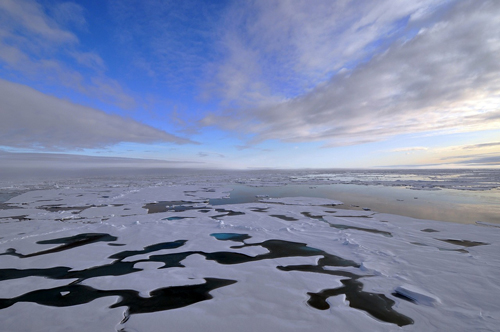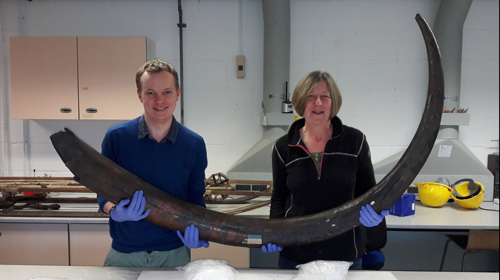Douglas Palmer ponders some of the geological upshots of the doomed Franklin Expedition
Palmer, D., Insight from catastrophe.
Geoscientist 29 (2), 18-21, 2019
https://doi.org/10.1144/geosci2019-010; Download the pdf

Sir John Franklin’s ill-fated expedition on HMS
Erebus, to find the North-West Passage between the Atlantic and Pacific Oceans, has often been in the news—most recently thanks to Michael Palin’s new book, ‘
Erebus: the story of a ship’ (see
book review).
And the story is an extraordinary one. The ship disappeared in 1845. Successive searches throughout the 19th century found artefacts and human remains, but it was not until 2014 that the wreck of HMS
Erebus was eventually found in cold Arctic waters. While the searches for survivors were initially fruitless, the search parties did discover a number of interesting geological artefacts.
Lady Franklin’s Lament
“Alas, she cried, all my life I’ll mourn,
Since Franklin seems never to return”
And so she did and so it was. The traditional ballad ‘Lady Franklin’s lament’ was sung from the 1850s onwards to the present, commemorating the loss of Sir John Franklin and 129 seamen. They were the doomed crews of HMS
Erebus and her sister ship HMS
Terror, which was also part of the expedition that aimed to navigate the North-West Passage in the Canadian Arctic.
Lady Jane Franklin’s determination to find the missing expedition and the offer of a substantial reward of 20,000 pounds for doing so resulted in a succession of search parties. In 1847, under pressure from the press and Lady Franklin, the Admiralty launched a major search from three directions. One led by Admiral John Ross was by sea through the Canadian Arctic Archipelago; another led by Sir John Richardson and John Rae went down the MacKenzie River to the Canadian Arctic coast and the third led by Henry Kellett was from the Pacific through the Bering Strait.
Kellett’s mammoth tusk
In 1848, Henry Kellett, captain of HMS
Herald, had been surveying the Pacific coast of North America. On May 9th the
Herald left Panama and sailed north through the Bering Strait, reaching Kotzebue Sound, Alaska on September 14th.
Whilst waiting for its depot ship HMS
Plover to arrive, Kellett and his naturalist, the German-born Berthold Seemann, took the opportunity to explore the nearby frozen ice cliffs of Eschscholtz Bay. Kellett and Seemann were aware that in 1816, a Russian expedition led by Captain Kotzebue had discovered what became Kotzebue Sound and the fossil-bearing ice cliffs of Eschscholtz Bay—named after Kotzebue’s naturalist Johann von Eschscholtz. The cliffs had also been investigated in 1826 by a British naval expedition led by Captain Frederick Beechey, an investigation that again turned up the bones of large animals.
Whilst Kellett did not find any trace of Franklin, he did find a spectacular cache of well-preserved mammoth tusks and other bones. As Berthold Seemann later wrote in his published
Narrative of the Voyage of H.M.S. Herald … ‘In 1848 we collected eight tusks of the antediluvian elephant, the largest of which, though broken at the point, was eleven feet six inches long, one foot nine inches in circumference at the base, and weighed 243 lbs. The tusks were accompanied by molar teeth, thigh bones, ribs, and … a great number of … bones, were disinterred.’ Altogether, extinct species of mammoth, horse, musk ox and bison were found, along with those of living moose and reindeer species.
 Right, Kellet’s tusk. Held here by Museum staff, the tusk is now on display as part of the Sedgwick Museum’s new exhibit on the ‘Ice Age’.
Right, Kellet’s tusk. Held here by Museum staff, the tusk is now on display as part of the Sedgwick Museum’s new exhibit on the ‘Ice Age’.
Antediluvian beasts
Seemann’s 1853 account included comments by the Scottish surgeon and naturalist Sir John Richardson who, along with John Rae, had navigated the Mackenzie River in search of Franklin. Richardson wrote that ‘The animals whose osseus remains now engage our attention ranged while living to the shore of an icy sea, and that by some sudden deluge …were swept from their pasture grounds ….we have evidence of diluvial action extending from the ultima Thule of the American polar sea so far southwards in the valley of the Mississippi.’ This was the common explanation given at the time and was little more than a version of the biblical Flood story.
However, Richardson, like many of his contemporaries realized that such an explanation was becoming increasingly untenable. As he went on ..‘I find it difficult, however, to account for the introduction of fossil remains in such quantity…the excellent state of preservation…the recent decay of animal matter shown by the existing odour, quantities of hair found in contact with a mammoth’s skull, the occurrence of the outer sheaths of bison horns, and the finding of vertebrae of bovine animals lying in their proper order of sequence, render it probable that entire carcasses were there deposited, and that congelation followed close upon their entombment.’
Within a decade or so there was a revolution in thinking about the antediluvian animals and deposits, which are so common across the landscapes of North America, northern Europe and Asia. A Swiss geologist Louis Agassiz, who had first-hand experience of the effects of glaciation in the Swiss Alps, persuaded British geologists, such as Adam Sedgwick in Cambridge and William Buckland in Oxford, that many features of upland Britain were the result of the action of ice rather than flood waters.
Missing the connection with their supply ship HMS
Plover and with winter approaching, Captain Kellett was unable to pursue his search for Franklin. HMS
Heritage returned to England via Hawaii, Hong Kong and South Africa. They arrived back in June 1851 and Captain Kellett dispersed his wonderful finds from the ice cliffs of Eschscholtz Bay to various museums, including the Sedgwick Museum in Cambridge.
Finding Franklin today
Eventually, thanks to the combined efforts of the Canadian Coast Guard, Ice Service, Navy, the Government of Nanavut and Parks Canada, along with modern technology, such as sonar and remotely operated vehicles, the wreck of Franklin’s ship, HMS
Erebus was found in 2014 in Victoria Strait offshore from King William Island in the Canadian Arctic Archipelago. Two years later the consortium found HMS
Terror some distance away in Terror Bay. Divers have recovered large numbers of artefacts, which are now being conserved at a new research facility on King William Island.
Climate Change in the Arctic
The ice cliffs of Eschscholtz Bay and their fossil bones, including Captain Kellett’s mammoth tusk, can now be seen as evidence for changing climate within the Ice Age. With lowered sea levels during cold glacials, Asia was connected to North America across the Bering Strait. And, when climates permitted, huge numbers of animals migrated back and forth across this landbridge. At times, animal populations in Alaska were decimated by phases of intense cold and the remains became incorporated into the freezing deposits of the permafrost. Much of that permafrost remains, but is being thawed out by today’s rising temperatures.
During the brief summer thaw, melting of the surface of the ice cliffs exposes occasional animal remains that were frozen and preserved in the mud and silt deposits formed during the Ice Age.
Douglas Palmer is Communications Officer at the Sedgwick Museum of Earth Sciences, Cambridge; e-mail: [email protected].uk
Further reading
Narrative of the voyage of H.M.S.
Herald during the years 1845-51, under the command of Captain Henry Kellett, R.N., C.B., by Berthold Seeman. Reeve and Co., London, 1853. 348 pp.